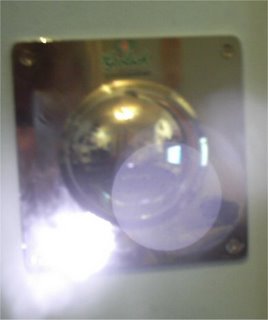Here's that picture again:

The orb, and the flare of reflected light at the bottom left, were not visible to the naked eye. They are composed of infrared light which the human eye cannot see. This is an infrared lamp. A small one. It's designed to fit on top of a digital camera. It produces all of two watts of light power. Not particularly powerful, I think you'll agree.
This is an infrared lamp. A small one. It's designed to fit on top of a digital camera. It produces all of two watts of light power. Not particularly powerful, I think you'll agree.
It's switched off in this photo. When you switch it on, it looks pretty much the same. There's a faint red glow from the infrared LED's but even that's hard to see unless you're looking directly at the front of the lamp. Human eyes can't see infrared.
Digital cameras can. Here's what a digital camera sees when that lamp is on.

The camera thinks you're shining a flashlight directly into the lens. The infrared is clearly visible to the camera as a powerful light source.
The circle of light is a consequence of infrared having different refractive properties to visible light. In a camera sold for domestic use, the lens is optimised for visible light. An expensive lens is better optimised for visible light. Infrared doesn't follow the same path through the lens. It's concentrated into a circle. An orb.
This is only one example of why I no longer rely on infrared lighting. This kind of lens flare occurs with both direct and reflected infrared light, as these pictures show. That 'orb' is a consequence of the infrared light catching the lens. I will personally guarantee that my wall-mounted bottle opener is not, in any way, haunted.
Infrared reflections can account for orb photos, whether it's a reflection from a surface or from floating dust. You might not have an infrared light. You might not be the one producing infrared in the location you're photographing.
It doesn't matter. Infrared can be produced by other sources, and your digital camera will see it anyway.
This is a lamp I've had for a long time, and no longer use for anything other than demonstrating why they are a bad combination with a digital camera. I know some people say 'Oh, but how can you dismiss infrared equipment when you say you don't use it?'
I did use it. I don't now. This is why.
Don't get distracted by orbs. If you can only see them with a digital camera, they aren't real. Corpse candles and other forms of ghost lights are visible to the naked eye. Those are worth investigating.
Orbs are not.
1 comment:
Interesting. What exactly is a corpse candle?
Post a Comment